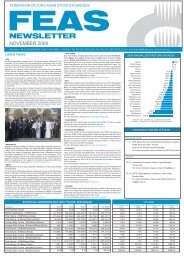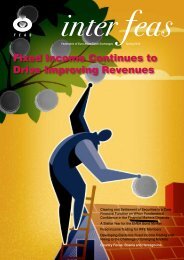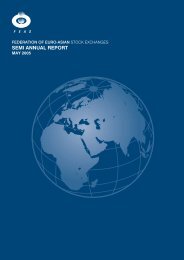Download - FEAS
Download - FEAS
Download - FEAS
Create successful ePaper yourself
Turn your PDF publications into a flip-book with our unique Google optimized e-Paper software.
FEDERATION OF EURO-ASIAN STOCK EXCHANGES SEMI ANNUAL REPORT OCTOBER 2005<br />
KYRGYZ STOCK EXCHANGE<br />
ECONOMIC AND POLITICAL DEVELOPMENTS<br />
Politic and Economic Environment:<br />
Although small and mountainous, Kyrgyzstan<br />
has potential for economic development.<br />
The country has steadfastly followed the<br />
prescribed Western reform template, but with<br />
modest success. Like many CIS nations,<br />
Kyrgyzstan experienced a steep decline in<br />
industrial production by the mid-1990s as the<br />
Soviet-era infrastructure and technology were<br />
not competitive in world markets. With the<br />
existing industrial sector in decline, the<br />
government elected to emphasize the<br />
agricultural sector, which performed<br />
especially well in 1997-1998, for near term<br />
growth. Kyrgyzstan also possesses<br />
significant amounts of mineral wealth<br />
including gold, mercury and uranium. While<br />
lacking major hydrocarbon deposits,<br />
Kyrgyzstan does have considerable<br />
hydroelectric power generation potential,<br />
much of it undeveloped, and exports<br />
electricity from its existing facilities.<br />
In 1994, new legislation was instituted that<br />
abolished the existing legislature, and<br />
replaced it with a smaller bicameral body.<br />
Elections for positions within the new<br />
legislature were held in 1995. At the end of<br />
1995, a new presidential election was called;<br />
Akayev won a commanding victory and was<br />
effectively re-elected. In 1996, the elimination<br />
of certain cabinet positions and a reshuffle of<br />
posts were decreed.<br />
ECONOMIC RATIOS<br />
PAGE 96<br />
Kyrgyzstan<br />
Lower-middle-income group<br />
In recent years, Akayev's vision has been to<br />
make Kyrgyzstan the "Switzerland" of Central<br />
Asia. To this end, governmental transition<br />
has continued. New changes in government<br />
were announced by Akayev in April 1998,<br />
cutting the number of deputy prime ministers<br />
from three to one, disbanding one ministry,<br />
reforming another to a state agency, and<br />
reshuffling the principal officials.<br />
Economic Performance:<br />
The Kumtor gold mine, which has propped<br />
up the economy since the middle of the last<br />
decade, recently had its reserve estimate<br />
substantially downgraded to a remaining<br />
economic life of less than 10 years, forcing<br />
Kyrgyzstan to look into other sources of<br />
growth for the future. In 2002, a landslide at<br />
the mine lowered production significantly,<br />
while bad weather led to lower hydroelectric<br />
energy production, causing a decline in GDP<br />
growth of 0.5% for the year. This was down<br />
from 5.3% growth in 2001. However, growth<br />
outside of mining and energy registered<br />
3.5% for the year, and growth in 1Q 2003<br />
was 4.7%, led by 15% growth in the nonmining<br />
sectors of energy and manufacturing,<br />
especially food processing, construction<br />
materials, and paper. To prepare the<br />
economy for the transition into non-mining<br />
endeavors, and to cull new sources of<br />
revenues to combat continuing deficits of 10-<br />
12% of GDP, the government is shoring up<br />
Key Information Contacts<br />
National Bank of the Kyrgyz Republic www.nbkr.kg<br />
Ministry of Finance www.minfin.kg<br />
State Commission on Securities Market www.nsc.kg<br />
4.Ministry of Foreign Trade and Industry of the Kyrgyz Republic www.mvtp.kg<br />
Domestic<br />
savings<br />
Trade<br />
Indebtedness<br />
Investment<br />
GROWTH OF INVESTMENT AND GDP<br />
(%)<br />
30<br />
20<br />
10<br />
0<br />
-10<br />
-20<br />
-30<br />
97<br />
GDI GDP<br />
the tax base with several new tax measures<br />
including an extension of the VAT. Strong<br />
demand for the currency kept the 12-month<br />
rate of inflation low relative to its regional<br />
trade partners, at 4.1% in May 2003. This<br />
reflected an increase from 2.3% at year-end<br />
2002, as food prices grew.<br />
The current account deficit narrowed to 2.6%<br />
of GDP in 2002 from 3.3% despite a weaker<br />
trade balance in 2001 as higher gold prices<br />
offset declines in gold and energy exports for<br />
the year. Kyrgyzstan has been successful,<br />
however, in petitioning a number of its<br />
bilateral creditors for debt re-scheduling. 1<br />
1 Economic and Political Overview, County Watch<br />
Incorporated, 2005<br />
98 99 00 01 02 03<br />
* World Bank reports
















